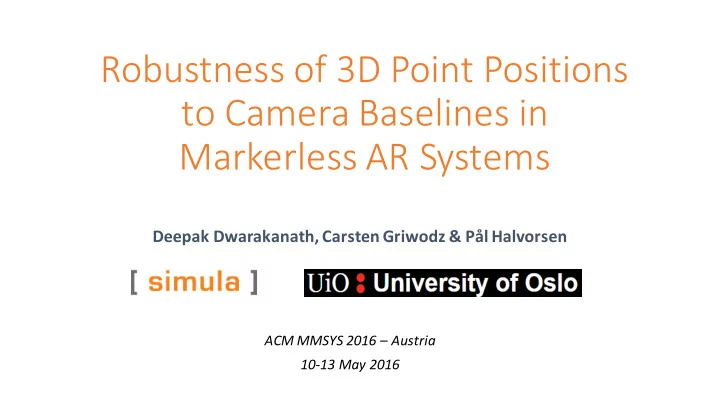

Robustness of 3D Point Positions to Camera Baselines in Markerless AR Systems Deepak Dwarakanath, Carsten Griwodz & Pål Halvorsen ACM MMSYS 2016 – Austria 10-13 May 2016
AR Application • POPART project • Quality of observer’s position depends on accuracy of camera pose • Markerless camera pose estimation is more challenging Augmented preview of the film set
Commonly Known normalized correlation coeff. Feature based calibration – camera pose angular displacement estimated using sparse feature points detected in the images - if the number of feature points is larger, the camera pose total matched features estimation is better normalized correlation coeff. angular displacement - minimizing the 2D error between the matched points yields better camera pose estimation pixel error (in pixels)
Scope • Accuracy of camera pose based on state-of-art feature detectors and descriptors cannot be guaranteed with variation in camera baselines • This paper explores the magnitude of such inaccuracy • Evaluation of several state-of-art feature extractors • Helps system builders to understand the operational limits and make better choices to design multimedia system • Helps also to determine camera density around a scene
Related evaluation work Focus on: • Correctness of the feature matches • Repeatability of features • Reprojection error in 2D • Limited candidates for evaluation In this paper: • Accuracy measured in 3D space metrics – relates to the problem directly • Several well-knownfeature extractors • Obtain operational limits for all tested feature extractors (under specific conditions)
Experimental - Overview
Experimental - Datasets • Turn-table configuration to keep the object size / distance constant • Camera centers 500 units from model’s geometric center in model coordinatesystem • 450 stereo pairs from 9 known models are captured at 60x600 resolution • Known values • 3D mesh vertices • Corresponding 2D pixel positions on stereo images • Camera focal length and principal axes • Cameras’ relative rotation and translation
Experimental - Feature Extractors • 26 feature extractor combinations using several detectors and descriptors • Detectors - MSER, STAR, FAST • Descriptors - BRIEF, FREAK • Detectors and Descriptors - SIFT, SURF, BRISK, KAZE, AKAZE and ORB • Brute force matching • RANSAC – outlier removal
Experimental - Pose Estimation Based on feature matching points in a stereo pair • Essential matrix (E) is estimated • Using SVD, E=[T]R • Cheirality constraint to select optimal solution • Hence, • Relative Rotation (R) • Relative Translation (T) are estimated • All measurements are in model coordinatesand in model units
Experiments - 3D Estimation and Accuracy Computation • Using feature-matchedpoints + camera pose, triangulation is performed • Resulting sparse3D points are compared with ground truth points • Computation in 3D space • Normalized Correlation Co-efficient error (used for comparative study) • Mean Squared Error (used for design recommendation along with some penalties)
Results - overview • Evaluation pipeline • 2D pixel error Expressed as Sampson Error – second order approximation of geometric error • Camera pose error Comparing estimated rotation and translation with known values (in 3 axes) • 3D estimation error Determines performance evaluation and helps in design recommendation
Results – 2D pixel error • Pixel errorsin 2D for matched features points are fairly low for varied baselines • This does not guarantee a high 3D accuracy
Results – Rotational Error • Rotational Error increases with the increase in camera baseline (a) & (b) • Although baseline refers to Ry, estimation of Rx,Rz results in non-zeros • FREAK descriptor performs poorly
Results – Translational Error • Translational Error increases with the increase in camera baseline (a) & (b) • FREAK descriptor performs poorly
Results – camera pose error • Possible reasons for camera pose error • Wrong matches even after outlier removal – wrong essential matrix • Feature point matches confined to an area – gives a wrong rotational estimation in terms of perspective • Penalities occur when: • Translation error is more than unity • Rotation is more than 90 degrees • No matches were found
Result - 3D error • Mean • Standard Deviation
Results – 3D error (More combinations)
Performance Evaluation Baseline (< 5) deg Baseline (5 – 30) deg Baseline (30 - 50) deg SIFT, KAZE, AKAZE – good SIFT, SURF, KAZE with their SIFT and KAZE perform performers own descriptors better than any other Rotation – translation BRIEF descriptor with all ambiguity exists detectors except MSER, STAR, FAST FREAK descriptor with SURF; BRISK ORB and KAZE • NCC – Normalized Correlation error – only a relative measure for comparison • However this is not sufficient to choose a feature extractor
Design recommendations • We consider MSE of the deviation is 3D reconstructed points • We incorporate the penalties incurred by the feature extractors over all models in a range of baselines. This is presented as reliability of the feature
Conclusion • SIFT and KAZE seem to be promisingin terms robustnessover large baselines • Low pixel error in matched features does not guarantee a good 3D accuracy; especially with variation in the camera baseline • 26 feature combinations over 50 camera baselines were studied • Design recommendation • To select feature extractor based on acceptable accuracy, execution time and reliability • To design the camera density to capture a scene for a given quality of service
Thank you
Recommend
More recommend